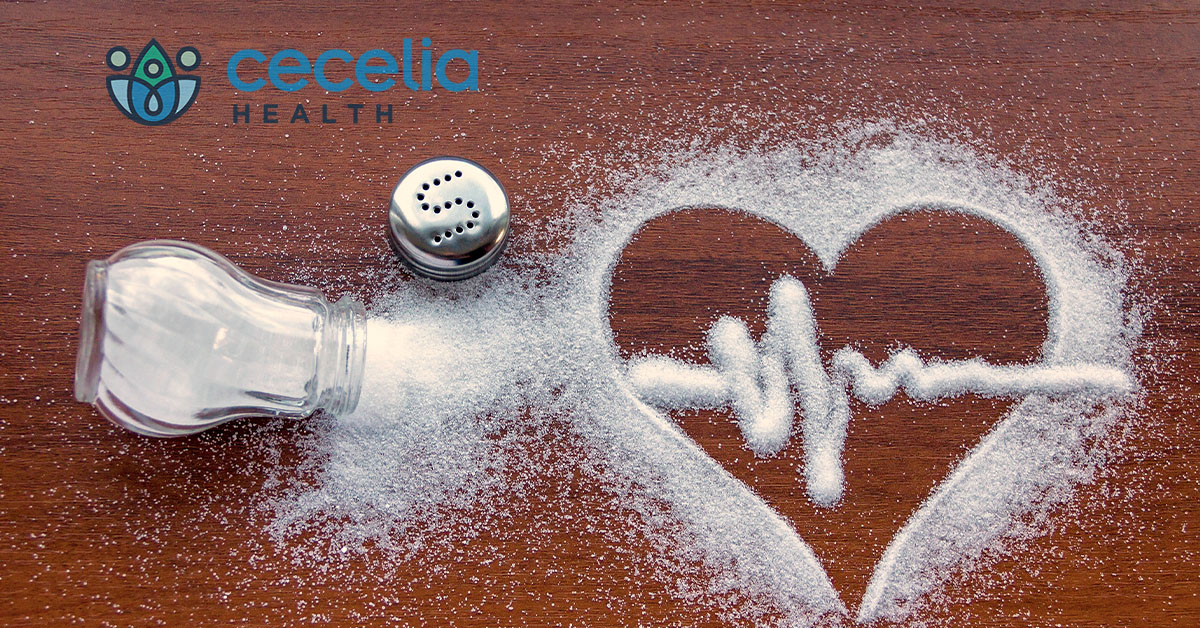If you aren’t paying attention to how much sodium you take in each day, it’s likely that you are consuming too much. According to the American Heart Association (AHA), American adults eat more than 3,400 milligrams of sodium daily- more than double the AHA’s recommendation of 1,500 milligrams. But where is all this sneaky salt coming from?
Here is where our dietary sodium is coming from:
- Processed and restaurant foods- 77%
- Naturally occurring- 12%
- Added while eating- 6%
- Added while cooking- 5%
When we really look at the numbers, only a minimal amount of our daily sodium intake comes from cooking at home. The big culprits are processed and restaurant foods. This makes it incredibly difficult to control how much sodium we eat, because it’s already there before we even buy it.
Sodium and the Heart
We know that too much sodium causes the body to retain water, and this increase in fluid puts a strain on the blood vessels, the heart and kidneys. Most people have no idea how much salt they are consuming. It’s important to pay attention to your sodium intake if you have high blood pressure. Additionally, if you have heart failure, too much sodium can be very dangerous.
Let’s look at a few simple ways to reduce the amount of sodium in your diet:
- Cook your meals at home. One of the best ways to reduce sodium in your diet is to just cook your meals at home using fresh ingredients. When you are preparing meals, keep in mind that steamed, baked, grilled or roasted rather than fried is always best. Try to cook with nutrient-rich foods like vegetables, fruits, legumes and whole grains. When preparing your meals from scratch, you’re better able to control how much salt goes into the dish.
- Season your food smartly. Instead of adding salt to your cooking, opt for using alternatives such as garlic, herbs, lemon and spices to enhance flavor. Vinegar is another smart alternative that helps to bring out the taste of food. Red wine vinegar has been used to enhance the flavor of everything from soups and stews, to sauces and salad dressings. A simple tip is to reduce balsamic vinegar over low heat, which can then be drizzled as a glaze over roasted vegetables for enhanced flavor.
- Try shopping online. When you order your groceries online and pick them up at the store or have them delivered, you have more control over what foods end up in your kitchen. Write out a shopping list and then search for each item in the toolbar on your favorite grocery store’s website. Shopping online saves you from choosing the packaged and processed foods that look appealing at the grocery store, but are loaded with sneaky sodium. An added bonus to shopping online is that the nutrition facts label and ingredients list are readily available for you to find.
- Shop savvy. Whether you shop online or prefer the store, limiting sodium requires some savvy shopping. Look for “low-sodium” or “no-sodium” when shopping for items such as canned beans (drain and rinse canned beans before cooking). Always avoid high salt foods such as smoked or cured meats, cold cuts, deli meats, canned soups and frozen dinners. Many cheeses such as parmesan and American cheese are higher in salt than the more natural cheeses like mozzarella or Swiss. The “Salty Six” are six popular foods that contain high amounts of sodium and should be avoided. Find the list of these foods here.
- Watch the condiments. Sauces, spreads, dressings and dips can have a tremendous amount of sodium that you may not even realize. Condiments such as ketchup, ranch, barbecue and soy sauce are a few that carry a lot of sodium and should be avoided. Switch to condiments that are labeled “salt-free” or “low-sodium” and be mindful of how much you add. Ask for your dressing or sauce to be on the side of the meal so that you can control how much you use if you are at a restaurant.
- Do your research. It is becoming much easier to control how much sodium you are consuming thanks to nutrition labels, online menus, and sodium-free alternatives. If you are tired of cooking at home and want to treat yourself to a dinner out, plan ahead by reviewing the online menu. This way you will be aware of what dishes are better for you before you even sit down at the table. Also, remember that some of the healthiest foods don’t need a nutrition label at all… think fresh fruit, vegetables and fish- or single ingredient foods like brown rice and chickpeas.
If you aren’t sure how to calculate the amount of sodium in your food, this article on how to read and interpret food labels is a great place to start. Also, make sure you are communicating with your doctor about how much dietary sodium is right for you.
Final Thoughts
Decreasing sodium in your diet is not as complicated as it sounds. Eating out less often and choosing to cook at home with fresh ingredients is a good starting point. From there, keep your sodium in check each day by reading food labels, and calculating how much you are eating. Branch out of your comfort zone by trying some new recipes that are low in sodium and big on flavor!
